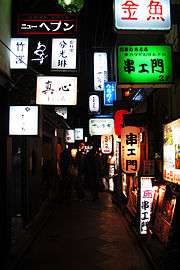Ponto-chō


Ponto-chō (先斗町) is a Hanamachi district in Kyoto, Japan, known for geiko and maiko and home to many geiko houses and traditional tea houses. Like Gion, Ponto-chō is famous for the preservation of forms of traditional architecture and entertainment.
Etymology
The name Ponto-chō is said to be a portmanteau of the Portuguese word "ponte" (bridge) and the Japanese word "-chō" meaning town, block or street.
District
Ponto-chō centres around one long, narrow, cobbled alley running from Shijō-dōri to Sanjō-dōri, one block west of the Kamo River (Kamo-gawa). This is also the traditional location of the start of kabuki, and a statue of Okuni still stands on the opposite side of the river. The district crest is a stylized water plover or chidori.
Cultural features
Geiko and maiko have existed in Ponto-chō since at least the 16th century, as have prostitution and other forms of entertainment. Today the area, lit by traditional lanterns at night, contains a mix of very expensive restaurants — often featuring outdoor riverside dining on wooden patios — geisha houses and tea houses, brothels, bars, and cheap eateries.
The area is also home to the Ponto-chō Kaburenjō Theatre at the Sanjō-dōri end of the street. This theatre functions as a practice hall for geiko and maiko and twice a year since the 1870s Kyoto geiko and maiko perform the Kamogawa Odori — Kamogawa river dancing, a combination of traditional dance, kabuki-like theatre, singing and the playing of traditional instruments — there, offering a rare chance for ordinary people to see performances by real geiko and maiko.
An American Liza Dalby became a geiko in Ponto-chō during college studies and later wrote a popular book favorable to the community there.[1]
See also
- 5 famous Hanamachi in Kyoto ("Gokagai")
- Gion-Kohbu
- Gion-Higashi
- Kamishichiken
- Miyagawacho
- Pontocho
- Another in Kyoto
References
External links
| Wikimedia Commons has media related to Pontocho. |
| Wikimedia Commons has media related to Pontocho riverside. |
- Ponto-cho Noren-kai(Japanese)
- Kamogawa Odori (Pontochō Kaburenjō Theater)
- 35°00′29″N 135°46′16″E / 35.007969°N 135.771111°ECoordinates: 35°00′29″N 135°46′16″E / 35.007969°N 135.771111°E (Pontochō Kaburenjō Theater)